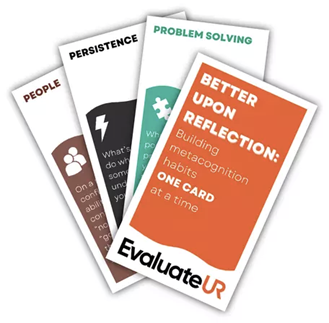by John Draeger, SUNY Buffalo State
In a series of previous posts, I have discussed some of the ways that Just-in-Time Teaching techniques can promote metacognition (Draeger, 2014, 2015, 2016). Just-in-Time assignments require that students complete short assignments prior to class and instructors review those assignments before class begins so that they can tailor their lesson based on those responses (Novak, 1999). My introductory philosophy courses typically have 40 students and my Just-in-Time assignments each involve three short essay questions prior to each class session. The questions have a predictable structure — one asks students to explicate a central idea in the reading, one asks them to engage in critical thinking about the reading (e.g., how might the author respond to an issue raised earlier in the semester), and one encourages metacognition (e.g., whether their reading strategy was effective). This post shares my attempts to promote metacognition through Just-in-Time techniques to a larger section of introductory ethics (175 students), and, it further explores how Just-in-Time assignments can promote metacognitive reading.
All of the students in my larger introductory ethics course are required to answer the Just-in-Time questions prior to each class via my institution’s learning management system. Because of the large number of students and short turn-around time, I have adapted the format of these assignments. I typically ask two multiple-choice questions related to the central ideas in the reading. I ask one short essay question encouraging critical thinking about the reading (e.g., how is the current reading related to the previous one?). I also ask one Likert-style question to gauge how confident they are in their understanding of the reading, and one short answer question to encourage them to be metacognitive about their learning process (e.g., what was your reading strategy for this reading?, what was your annotation strategy?, or what was your strategy for relating the current reading to the previous?).
Before each class, I review a computer generated summary of the multiple-choice questions to gauge broad understanding of the material and look for trends. For example, their responses to the Likert-style question gauging their confidence in their understanding of the material often overestimate their actual understanding as determined by the multiple-choice questions, critical thinking essay, and overall course performance. However, this difference can serve as a conversation starter about their performance in the course. In some cases, I also ask Likert-style questions related to the author’s central thesis. So, for example, when we read an essay on sexual harassment, I asked them how often they believed sexual harassment occurred, with response options of daily, weekly, monthly, annually, and never. This Likert question became the opening move in our conversation during the next lesson. I shared that 87% reported that sexual harassment occurs at least daily or weekly. This led to an open-ended discussion about the sorts of behaviors that counted as harassment. In this way, Just-in-Time assignments can both inform and facilitate class conversation about the material.
Just-in-time assignments can also inform and facilitate conversations about how to become more metacognitive about learning; in this class I focus on their reading skills. For example, I recently asked students a Likert-style question about whether they have changed their reading practices since the beginning of the semester and a follow-up short answer question regarding how their practices have changed. 74% of students reported that their reading practices have changed. A number of interesting themes emerged in their description of those changes. First, many students reported moving to the “next stage” of their reading practice. Students moved (a) from not doing the reading to at least skimming, (b) from skimming until they got bored to finishing the reading, (c) from reading to re-reading, and (d) from re-reading to re-reading with an aim to synthesize the large themes. These responses also highlight to me the fact that not all students are in the same place with respect to their learning practices, so I should not make generalized assumptions, nor assume that one recommendation from me will accurately match all students’ developmental needs. Second, students reported changes in their annotation strategies. They moved from no highlighting to highlighting and from highlighting to more intentional annotation strategies (e.g., outlining in the margins, summarizing important thesis, adding critical questions in the margins). Third, students reported using strategies that we’d previously discussed in class (e.g., reading with different speeds, developing intentional annotations, reading the conclusion first and then reconstructing how the author gets there). Fourth, some students transformed their view of what reading philosophy is really about (e.g., they moved from reading for “information” to looking for the conceptual connections between big ideas). Finally, students reflected on the importance of time-management (e.g., devoting more time to the reading task, finding better physical reading environments, finding times in the day when they are more like to be able to process philosophy). Responses from the 26% of students who had not changed their reading practices were similarly illuminating. For example, most reported that they recognized a change was in order even if they had not yet managed to change. They also identified problems with their current reading practices. For example, they said that they waited until the last minute and rushed through Just-in-Time assignments. They recognized the value of intentional annotation and expressed the hope that they would eventually adopt those practices. And some students were able to diagnose why they were struggling (e.g., they quickly lose patience with authors who do not share their point of view). In short, Just-in-Time assignments can promote metacognitive reading by encouraging students to intentionally consider and evaluate their reading techniques as well as facilitate conversations about alternative reading strategies.
It should come as no surprise that teaching introductory ethics to a section of 175 students differs from teaching to a section of 40 students. However, it is clear that the Just-in-Time teaching technique is not only viable in a large class, but it can promote metacognition about learning as well as inform me about their level of content understanding. Indeed, teaching a larger section has led me to better ways of encouraging conversations with students about their learning process.
References
Draeger, J. (2014). “Just-in-Time for Metacognition.” Retrieved from https://www.improvewithmetacognition.com/just-in-time-for-metacognition.
Draeger, J. (2015). “Using Just-in-Time assignments to promote metacognition.” Retrieved from https://www.improvewithmetacognition.com/using-just-in-time-assignments-to-promote-metacognition.
Draeger, J. (2016). “Fine-tuning Just-in-Time assignments to encourage metacognition.” Retrieved from https://www.improvewithmetacognition.com/fine-tuning-just-time-assignments-encourage-metacognition/
Novak, G., Patterson, E., Gavrin, A., & Christian, W. (1999). Just-in-time teaching: Blending active learning with web technology. Upper Saddle River, NJ: Prentice Hall.



